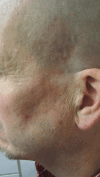A Unique Case of Progressive Hemi-facial Atrophy Successfully Treated with Methotrexate
- PMID: 33655107
- PMCID: PMC7746048
- DOI: 10.51894/001c.5783
A Unique Case of Progressive Hemi-facial Atrophy Successfully Treated with Methotrexate
Abstract
The effects of many dermatologic syndromes are not exclusive to the skin. Disorders commonly involve a complex interplay between multiple organ systems, thus not relying solely on the dermatologist for proper work up, diagnosis, and treatment. Morphea is one such rare disease which involves progressive loss or atrophy of subcutaneous tissue, muscle, and bone with a relatively mysterious etiology. The initial lesion of morphea can be subtle and appear as a pink to red plaque without any additional symptomatology. A biopsy at this early stage is non-specific and will only show the presence of a T cell infiltrate, vascular swelling, and edema. This active or progressive stage will continue for years before "burning out," or halting progression, although still affecting underlying tissues. Many times, the sclerosis becomes severe enough to cause deformity and secondary systemic symptoms. Five general subtypes of morphea exist, including: plaque-type, linear, deep, guttate, and nodular. In this paper, the authors report a case report of a rare subtype of linear morphea called Parry Romberg syndrome, also known as progressive hemi-facial atrophy (PHA). PHA usually involves at least one branch of the trigeminal nerve unilaterally. The authors will emphasize the importance of a multidisciplinary approach to diagnose and treat this disorder while also considering the multiple theories surrounding its pathophysiology.
Keywords: morphea; parry-romberg syndrome; progressive hemi-facial atrophy.
Conflict of interest statement
The authors have no financial or other conflicts of interest to disclose.
Figures
Similar articles
-
Scleroderma and dentistry: Two case reports.J Med Case Rep. 2016 Oct 24;10(1):297. doi: 10.1186/s13256-016-1086-1. J Med Case Rep. 2016. PMID: 27776552 Free PMC article.
-
Parry-romberg syndrome: a rare case report.J Oral Maxillofac Res. 2011 Jul 1;2(2):e5. doi: 10.5037/jomr.2011.2205. eCollection 2011. J Oral Maxillofac Res. 2011. PMID: 24421992 Free PMC article.
-
Seizure in Morphea: A Case Report of Parry-Romberg Syndrome.Cureus. 2024 Jul 23;16(7):e65210. doi: 10.7759/cureus.65210. eCollection 2024 Jul. Cureus. 2024. PMID: 39176365 Free PMC article.
-
Ophthalmological manifestations of Parry-Romberg syndrome.Surv Ophthalmol. 2016 Nov-Dec;61(6):693-701. doi: 10.1016/j.survophthal.2016.03.009. Epub 2016 Apr 1. Surv Ophthalmol. 2016. PMID: 27045226 Review.
-
Progressive hemifacial atrophy: a review.Orphanet J Rare Dis. 2015 Apr 1;10:39. doi: 10.1186/s13023-015-0250-9. Orphanet J Rare Dis. 2015. PMID: 25881068 Free PMC article. Review.
Cited by
-
Disturbances of the stomatognathic system and possibilities of its correction in patients with craniofacial morphea.Postepy Dermatol Alergol. 2023 Oct;40(5):592-598. doi: 10.5114/ada.2023.131865. Epub 2023 Nov 9. Postepy Dermatol Alergol. 2023. PMID: 38028421 Free PMC article. Review.
-
Parry-Romberg syndrome in an adolescent: a case report on progressive hemifacial atrophy.Oxf Med Case Reports. 2020 Jan 31;2020(1):omz127. doi: 10.1093/omcr/omz127. eCollection 2020 Jan. Oxf Med Case Reports. 2020. PMID: 32038874 Free PMC article.
References
-
- A review of Parry-Romberg syndrome. El-Kehdy J., Abbas O., Rubeiz N. 2012J Am Acad Dermatol. 67(4):769–784. - PubMed
-
- Clinical and serological characteristics of progressive facial hemiatrophy: A case series of 12 patients. Sommer A., Gambichler T., Bacharach-Buhles M., Rothenburg T., Altmeyer P., Kreuter A. 2006J Am Acad Dermatol. 54(2):227–233. - PubMed
-
- En coup de sabre morphea and Parry-Romberg syndrome: a retrospective review of 54 patients. Tollefson M.M., Witman P.M. 2007J Am Acad Dermatol. 56(2):257–263. - PubMed
Publication types
LinkOut - more resources
Full Text Sources


